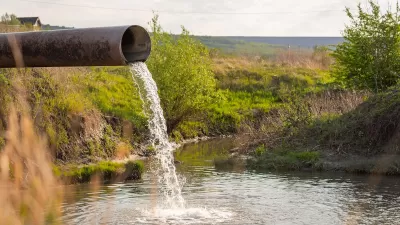According to a new EPA draft assessment, fracking has not caused pollution of drinking water, though concerns are raised. The report has yet to be reviewed by the Science Advisory Board and is now receiving public comment.
Based on the findings of the draft assessment, "the Environmental Protection Agency says it has found no evidence that hydraulic fracturing — better known as fracking — has led to widespread pollution of drinking water," reports Jeff Brady, energy correspondent for National Public Radio.

Credit: EPA: The Hydraulic Fracturing Water Cycle
"We found the hydraulic fracturing activities in the United States are carried out in a way that has not led to widespread systemic impacts on drinking water resources," [italics added] says Tom Burke, science adviser and deputy assistant administrator of the EPA's Office of Research and Development."In fact, the number of documented impacts to drinking water resources is relatively low when compared to the number of fractured wells," he adds.
The report, done at the behest of Congress, "is the most complete compilation of scientific data to date," says Burke, "including over 950 sources of information, published papers, numerous technical reports, information from stakeholders and peer-reviewed EPA scientific reports."
While the preliminary outcome is pleasing to the energy industry, environmentalists, who "have long argued fracking comes with a cost to the environment, especially to water," criticized the findings. In a press release, Food & Water Watch accused the study of having "the industry's oil fingerprints all over it:"
It is outrageous that the oil and gas industry refused to cooperate with the EPA on a single ‘prospective case study.’ This reveals the undue influence the industry has over the government and shows that the industry is afraid to allow careful monitoring of their operations.”
"The American Petroleum Institute says the conclusions echo what the oil industry has argued all along," writes Brady. “After more than five years and millions of dollars, the evidence gathered by EPA confirms what the agency has already acknowledged and what the oil and gas industry has known,” said API Upstream Group Director Erik Milito in their press release.
"The report also raises concerns about wells that are inadequately cased or cemented — something that can allow gases and liquids to migrate below ground," writes Brady. "Another area of vulnerability the EPA highlights in its report is how wastewater and fracking fluids from drilling operations are handled and treated."
Public comment is being accepted via the Federal Register.
Listen to the report here.
FULL STORY: EPA Finds No Widespread Drinking Water Pollution From Fracking

Alabama: Trump Terminates Settlements for Black Communities Harmed By Raw Sewage
Trump deemed the landmark civil rights agreement “illegal DEI and environmental justice policy.”

Study: Maui’s Plan to Convert Vacation Rentals to Long-Term Housing Could Cause Nearly $1 Billion Economic Loss
The plan would reduce visitor accommodation by 25% resulting in 1,900 jobs lost.

Planetizen Federal Action Tracker
A weekly monitor of how Trump’s orders and actions are impacting planners and planning in America.

This Toronto Suburb Has More Bus Riders Than Columbus, Ohio
Brampton, Ontario used gradual improvements in service to prove that if you build it, they will ride.

Paris Bike Boom Leads to Steep Drop in Air Pollution
The French city’s air quality has improved dramatically in the past 20 years, coinciding with a growth in cycling.

Why Housing Costs More to Build in California Than in Texas
Hard costs like labor and materials combined with ‘soft’ costs such as permitting make building in the San Francisco Bay Area almost three times as costly as in Texas cities.
Urban Design for Planners 1: Software Tools
This six-course series explores essential urban design concepts using open source software and equips planners with the tools they need to participate fully in the urban design process.
Planning for Universal Design
Learn the tools for implementing Universal Design in planning regulations.
Smith Gee Studio
Alamo Area Metropolitan Planning Organization
City of Santa Clarita
Institute for Housing and Urban Development Studies (IHS)
City of Grandview
Harvard GSD Executive Education
Toledo-Lucas County Plan Commissions
Salt Lake City
NYU Wagner Graduate School of Public Service




























